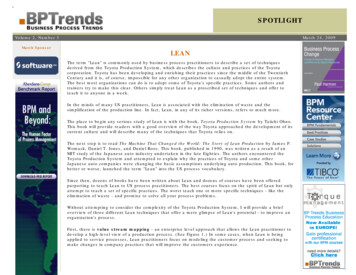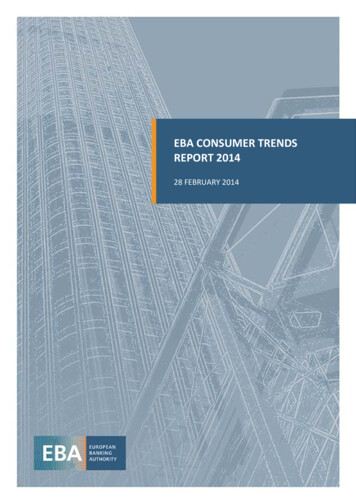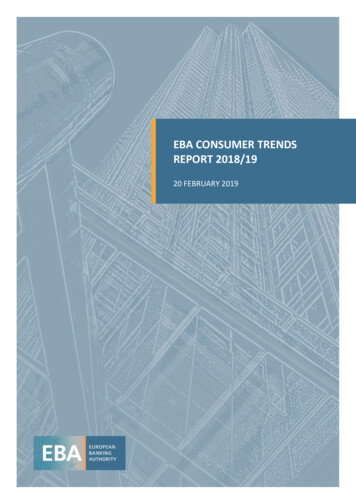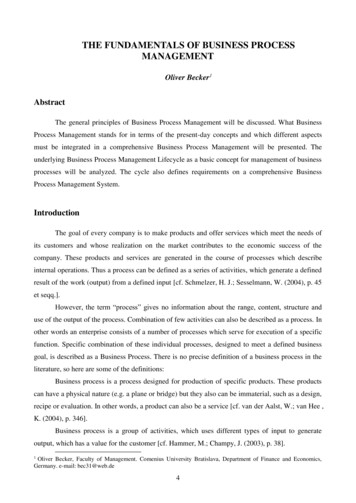
Transcription
SPOTLIGHTVolume 2, Number 3March SponsorMarch 24, 2009LEANThe term "Lean" is commonly used by business process practitioners to describe a set of techniquesderived from the Toyota Production System, which describes the culture and practices of the Toyotacorporation. Toyota has been developing and enriching their practices since the middle of the TwentiethCentury and it is, of course, impossible for any other organization to casually adopt the entire system.The best most organizations can do is to adopt some of Toyota's specific practices. Some authors andtrainers try to make this clear. Others simply treat Lean as a proscribed set of techniques and offer toteach it to anyone in a week.In the minds of many US practitioners, Lean is associated with the elimination of waste and thesimplification of the production line. In fact, Lean, in any of its richer versions, refers to much more.The place to begin any serious study of Lean is with the book, Toyota Production System by Taiichi Ohno.This book will provide readers with a good overview of the way Toyota approached the development of itscurrent culture and will describe many of the techniques that Toyota relies on.The next step is to read The Machine That Changed the World: The Story of Lean Production by James P.Womack, Daniel T. Jones, and Daniel Roos. This book, published in 1990, was written as a result of anMIT study of the Japanese auto industry undertaken in the late Eighties. The authors encountered theToyota Production System and attempted to explain why the practices of Toyota and some otherJapanese auto companies were changing the basic assumptions underlying auto production. This book, forbetter or worse, launched the term "Lean" into the US process vocabulary.Since then, dozens of books have been written about Lean and dozens of courses have been offeredpurporting to teach Lean to US process practitioners. The best courses focus on the spirit of Lean but onlyattempt to teach a set of specific practices. The worst teach one or more specific techniques - like theelimination of waste - and promise to solve all your process problems.Without attempting to consider the complexity of the Toyota Production System, I will provide a briefoverview of three different Lean techniques that offer a mere glimpse of Lean's potential - to improve anorganization's process.First, there is value stream mapping - an enterprise level approach that allows the Lean practitioner todevelop a high-level view of a production process. (See Figure 1.) In some cases, when Lean is beingapplied to service processes, Lean practitioners focus on modeling the customer process and seeking tomake changes in company practices that will improve the customers experience.
Figure 1. A Flow Kaizen model or Value Stream Map that allows Lean practitioners to study aproduction flow and focus on inventory and the push-pull emphasis of the various activitiesthat make up the process.Figure 2 provides an overview of the "Seven Types of Waste." In this case, practitioners at the processredesign level focus on eliminating activities that are wasteful. The definitions of waste incorporated inFigure 2 is broader than some might think and opens up many useful vistas to practitioners looking atprocesses and trying to consider how to make them run more efficiently.
Figure 2. An overview of the seven types of waste that Lean practitioners seek to eliminatewhen they work to improve the value produced by a process.Finally, Figure 3 illustrates an A3 diagram. (A3 is a paper size, roughly equivalent to a 16x11 inch page inthe US.) The term was adopted because Toyota requires that project managers summarize what theyknow about a problem on a single sheet of A3 paper. At a minimum, an A3 diagram provides a niceoverview of the phases a project manager goes through when he or she works to improve a process.More broadly, however, A3 captures the management culture at Toyota. Senior managers seek tostructure their mentoring efforts by means of the A3 approach. The new manager is given a challengeand asked to seek a solution which he or she is to summarize on an A3 page. The first draft is usuallywoefully deficient, and an iterative process is begun in which the project manager and the senior managerwork to better understand the problem, using techniques like "Five Hows" and "Cause-Effect" diagrams,and finally to define a solution.
Figure 3. An A3 Project Summary that is used to structure interactions between projectmanagers and their superiors. (After John Shook, Managing to Learn. Published by the LeanEnterprise Institute in 2008.)While many companies capture the idea of trying to eliminate waste, fewer capture the importance ofFlow Kaizen diagrams and broad overviews of processes. Still fewer are prepared to embrace themanagement style and commitment to developing employees that is embodied in the A3 approach toprocess improvement.In passing, alert readers will realize that many of our figures have referred to work that originated at theLean Enterprise Institute (www.lean.org). This is a non-profit organization founded by John Womack thatpublishes some of the best materials on Lean that we've found. Below I have listed some of the articlesand book reviews BPTrends has published on Lean. Several are reprints of Articles John Womackpublished or describe books published by the Lean Enterprise Institute. Once you have learned what youcan from the Articles listed below, you can continue your Lean education at the Lean Enterprise Institutewebsite.From Staffs Conducting Programs to Line Managers Solving Problems - James Womack -
November 04, 2008James Womack describes a scenario that he frequently encounters when visiting organizations whereLean Programs have existed for several years. He is often asked by team members why their successfulLean initiatives don't translate to bottom line improvement. This Article is a must read for any and all whohave been involved in Lean programs.Lean versus Six Sigma - Paul Harmon - March 25, 2008After we last wrote on Lean Six Sigma we had several readers write to argue that Six Sigma and Leanwere, in fact, quite different. In this Advisor, we look at both and consider how the two approachescomplement and contrast with each other.Lean for Dummies, Six Sigma for Dummies - Reviewed by Paul Harmon - June 05, 2007These two books provide good overviews of their respective topics and provide business managers withan excellent way to come up to speed on both Lean and Six Sigma.The Power of Two: Lean Six Sigma and BPM - Lance Gibbs & Tom Shea - April 01, 2007Lance Gibbs and Tom Shea consider the benefits that accrue to an organization when Lean Six SigmaTeams and BPM teams combine efforts. They offer useful guidelines for getting these two groups alignedon process projects to achieve positive results.Lean Tools That Improve Processes: An Overview - Forrest Breyfogle - March 06, 2007In this Article, Forrest Breyfogle describes Lean Tools, their uses and advantages, and how they can bestbe implemented in the organization.The Challenge of Lean Transformation - Jim Womack - January 02, 2007Read Jim Womack's astute observations on the current state of Lean Management and his proposal forthree simple elements of Lean Management worthy of experimentation.Lean Six Sigma That Works - Reviewed by Paul Harmon - December 05, 2006This month Paul Harmon looks at a new book on Lean Six Sigma and considers how well the twotechnologies go together and discusses how well this book describes an integrated approach to processimprovement.:: email us:: Visit BPTrendsA Tale of Two Business Systems - James Womack - April 03, 2006In 1990, James Womack joined with Dan Jones and Dan Roos to co-author The Machine That ChangedThe World - a description of how Toyota was using Lean techniques to change auto manufacturing. In thisthoughtful article Womack, who now heads the Lean Enterprise Institute, reflects on what has happenedsince The Machine was published.Enterprise Transformation - Paul Harmon - May 31, 2005There is a movement afoot in the Six Sigma community to integrate Six Sigma, Lean, Business ProcessFrameworks, and Business Process Management efforts. It's a welcome development that should bebroadly supported.Lean Memory Jogger by Richard L. MacInnes - Reviewed by Paul Harmon - March 01, 2005This small memory jogger from GOAL/QPC can save a busy manager a lot of time by putting all the basicconcepts and tools of Lean right at his or her fingertips.
Using Lean, Six Sigma, and SCOR To Improve Competitiveness - Dan Swartwood - October 07,2003Dan Swartwood, a senior consultant for PRAGMATEK, describes how Lean, Six Sigma, and SCOR areevolving toward an integrated framework for tackling supply chain redesign.Till next time,Paul HarmonBusiness Process Trends · 88 Waban Park · Newton · MA · 02458
Frameworks, and Business Process Management efforts. It's a welcome development that should be broadly supported. Lean Memory Jogger by Richard L. MacInnes - Reviewed by Paul Harmon - March 01, 2005 This small memory jogger from GOAL/QPC can save a busy manager a lot of time by putting all the basic










